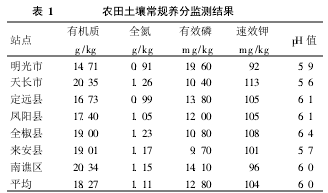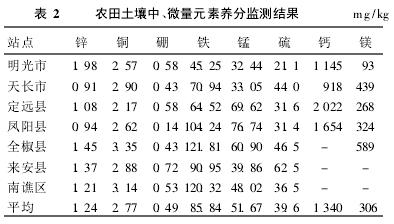Analysis on Investigation and Investigation of Farmland Soil Nutrient in Zhangzhou
Bozhou City is located between the Jianghuai and Huai Rivers in the eastern part of Gansu and is an agricultural city with agriculture as the mainstay. The city’s existing aerial survey of arable land is 704,100 hm2, accounting for approximately 9.6% of the province’s total arable land. According to the data of the second soil survey, the city has four major soils: soil, semi-aquic soil, leachable soil and primary soil; paddy soil, fluvo-aquic soil, purple soil, black lime soil, coarse bone soil, etc. There are 20 sub-categories of yellow brown earth, viscous yellow-brown soil, neutral purple soil, brown lime soil, oyster-type paddy soil and infiltration-type paddy soil; 65 soil genus and 118 soil species.
1 Investigation method of farmland soil nutrient 1.1 in Luzhou City With the help of the project, establish and improve the soil fertilizer testing system Since 2005, 2 cities, 4 counties and Nanxun District, including Mingguang, Tianchang, Dingyuan, Fengyang, Laian, Quanjiao, etc., have successively To undertake the implementation of the National Funding, Fertilizer, and Fertilizer Subsidy Program. We have established and improved 8 modern and standardized soil and fertilizer laboratories with a total area of ​​2,300 m2, over 500 sets of equipment and equipment, and more than 50 part-time laboratory workers.
1.2 Extensive distribution, construction of arable land quality monitoring network Monitoring of arable land quality is a long-term, basic, and public welfare work in the soil and fertilizer sector. According to the principle of “reasonable layout†and “step-by-step implementationâ€, and 5 requirements for the national arable land quality monitoring regulations, 6 258 long-term positioning monitoring points for arable land quality and over 40,000 soil agrochemical sampling points were established in batches throughout the city. It covers 5 soil types, 10 subtypes, 35 soil types and more than 50 soil types.
1.3 Soil testing, controlling the soil nutrient dynamics of the farmland in the past few years. Combined with the soil testing and fertilization project implementation, more than 40,000 soil samples were collected. Analyzed soil organic matter, total nitrogen, available phosphorus, available potassium, pH value and exchangeability. Calcium, magnesium and effective boron, zinc, manganese, sulphur, copper, iron and other projects, totaling about 450,000 items.
The results of the soil nutrient tester are shown in Tables 1 and 2.

Note: Organic matter: Potassium dichromate titration method; Total nitrogen: Semi-micro Kelda method; Available phosphorus: Neutral or calcareous soil extracted with sodium bicarbonate, molybdenum antimony anti-colorimetric method; Acid soil with ammonium fluoride ) hydrochloric acid extraction, molybdenum antimony anti-colorimetric method; ? available potassium: ammonium acetate extraction, flame photometry; pH ​​value: potentiometric method.

Note: Effective boron: boiling water extraction, curcumin colorimetric method; effective iron, manganese, copper, zinc: DT-PA extraction, atomic absorption spectrometry; exchangeable calcium, magnesium: ammonium acetate exchange - atomic absorption spectrophotometry ; Effective sulfur: phosphate extraction, barium sulfate turbidimetry.
2 Analysis of farmland soil nutrients in Zhangzhou City 2.1 Analysis of farmland soil nutrient status According to the analysis of farmland soil nutrient monitoring results in the city, the average content of farmland soil organic matter in Cangzhou is 18.27g/kg, with a range of 0.54~61.60 g/kg; The average content of nitrogen was 1.11 g/kg, which varied from 0.01 to 3.90 g/kg; the average content of available phosphorus was 12.8 mg/kg, which varied from 1.0 to 120.5 mg/kg; and the average content of available potassium was 104 mg. /kg, with a range of 5.0 to 547.0 mg/kg.
2.1.1 Soil organic matter. The test sample 32 303, an average content of 18.27g/kg. Among them, 1 276 samples below 10 g/kg accounted for 4.0%; 7 to 142 samples for 10 to 15 g/kg, accounting for 22.1%; 13 020 samples for 15 to 20 g/kg, accounting for 40.3% 20 to 30 g/kg was 10 264 samples, accounting for 31.8%; 30 g/kg was more than 606 samples, accounting for 1.9%. The majority was concentrated below 20 g/kg, indicating that the soil organic matter content in Quzhou City needs to be improved. Compared with the initial period of the second soil survey in 1982, the soil organic matter content in the city has increased, with an increase of 3.67 g/kg.
2.1.2 Soil total nitrogen. 32 334 samples were detected, with an average content of 1.11 g/kg.
Among them, 4 244 samples were below 0.8 g/kg, accounting for 13.1%; 0. 8~1. 0 g/kg were 7 789 samples, accounting for 24.1%; 1.0~1.2 g/kg were 9 075 samples. 28.1%; 1. 2~1. 5 g/kg was 8 436 samples, accounting for 26.1%; 1. 5g/kg more than 2 790 samples, accounting for 8.6%. More than 90% are concentrated below 1.5 g/kg, indicating that the level is not high enough to be improved. Compared with the initial period of the second soil survey in 1982, the soil total nitrogen content was basically the same, only increased by 0.2 g/kg.
2.1.3 Available phosphorus in soil. The test sample 32 179, the average content of 12. 8mg/kg. Among them, 7 895 samples of 7 mg/kg or less accounted for 24.5%; 15 to 130 samples of 7 to 14 mg/kg, accounting for 47%; 5 116 samples of 14 to 20 mg/kg, accounting for 15.9%; 20 ~30 mg/kg was 2 451 samples, accounting for 7.6%; 30 mg/kg was more than 1 587 samples, accounting for 4.9%. More than 70% were concentrated below 14mg/kg, indicating that the content of available phosphorus in the city was not high, although it was 7.16mg/kg higher than the initial period of the second soil survey in 1982, but the level was still low.
2.1.4 Soil available potassium. There were 32 303 soil tester samples with an average content of 104 mg/kg. Among them, 1 089 samples were below 50 mg/kg, accounting for 5.6%; 16 253 samples were 50~100 mg/kg, accounting for 50.3%; 10 529 samples were taken between 100~150 mg/kg, accounting for 32.6%; 150~200 The mg/kg was 2889 samples, accounting for 8.9%; more than 200mg/kg 823 samples, accounting for 2.5%. Nearly 60% are concentrated below 100mg/kg, and nearly 90% are concentrated below 150mg/kg, indicating that the soil available potassium content in this city is not high, which is a potent or effective area of ​​potash fertilizer. Compared with the initial soil census in the second 1982, it decreased by 11 mg/kg, with an average annual decrease of 0.4 mg/kg.
2.1.5 Soil pH. 32,280 samples were tested and the average pH value was 6.0. Among them, 1 923 samples were below 5.0, accounting for 6%; 17 895 samples were sampled from 5.0 to 6.0, accounting for 55.4%; 10,000 samples were sampled from 6.0 to 7.0, accounting for 31%; 1 730 samples were taken between 7.0 and 8.0, accounting for 5 3%; 8. 0 or more 732 samples, accounting for 2.3%. Nearly 60% are concentrated below 6.0, which belongs to acidic soils; 90% or more are below 7.0, which indicates that the soil acidification in the city is aggravated and should be highly noticed.
2.1.6 Soil, trace elements. According to the analysis of monitoring results, the average effective zinc content of farmland soil in the city is 1.24 mg/kg, ranging from 0.01 to 15.51 mg/kg, which is lower than 1.0 mg/kg, accounting for 46%, and it is in the range of zinc deficiency; The average boron content was 0.49 mg/kg, the amplitude was 0.01 to 5.80 mg/kg, and 2/3 was lower than the critical value (0.5 mg/kg); the average effective sulfur content in soil was 39.6 mg/kg, varying from 1.2 to 285. 9 mg/kg, 41% is less than 30 mg/kg, which belongs to the category of effective or effective sulfur fertilizer. Other exchangeable calcium, magnesium and effective manganese, copper, iron and other projects are basically not missing.
2.2 Distribution Characteristics of Farmland Soil Nutrients in Zhangzhou City 2.2.1 The soil organic matter and total nitrogen are decreasing from east to west and from south to north.
The monitoring results showed that the average content of soil organic matter in Tianchang, Nanzhao, Laian, Quanjiao and other four counties (cities, districts) was above 19.0 g/kg, an average of 5.0 g/kg higher than that of Mingguang City, an increase of 4.29. 5. 64 g/kg. Soil total nitrogen is basically the same as organic matter. The average contents of four counties (cities, districts) such as Tianchang, Nanzhao, Laian, Quanjiao are all above 1.0g/kg.
2.2.2 The available phosphorus in the soil is in the south and low in the north. The monitoring results showed that the average content of available P in farmland soil in Mingguang City was 19.6 mg/kg, which was higher than Lai'an County (9. 7 mg/kg), Tianchang City (10. 4 mg/kg) and Quanjiao County (10.8 mg). /kg) 9.9 mg/kg, 9.2 mg/kg, and 8.8 mg/kg higher.
3 The causes of farmland soil nutrient evolution in Chuzhou City and suggestions for improvement and utilization 3.1 Straw returning technology is an important measure to increase soil organic matter and total nitrogen content in farmland Since the reform of the rural economic system, the enthusiasm of farmers for farming has increased, and fertilizers, pesticides and improved seed input have increased. As a result, the increase in the yield of agricultural products has been promoted, and the amount of straw and roots that have been returned to farmland has also increased, which has promoted the increase of organic matter and total nitrogen content in the farmland soil of Chenzhou City. We will vigorously promote the technology of returning straw to the field, promote organic and inorganic fertilizers, and achieve high-quality, high-yield, high-efficiency, and sustainable development of agricultural production in the city.
3.2 Phosphate fertilizer input is the key to promote the significant increase of available phosphorus content in farmland In 1980, the cumulative application of phosphate fertilizer (P2O5, the same below) was only 9 345, t increased to 49 985 in 1995, t turned closer than 1980 5.35 times. Although it has declined in recent years, the annual application rate is still more than 45,000 tons.
3.3 Insufficient potassium input is the root cause of the decrease of available potassium content in farmland. The shortage of potassium resources in China, and the lack of production, potassium depends mainly on imports.
In addition, the use of crop straw as a potassium source has decreased from more than 95% in the 1980s to less than 60% at present, which has aggravated the decrease of available potassium content in the farmland soil of Chenzhou City. The vigorous promotion of soil testing and formula fertilization techniques and the scientific application of potassium have become the key to farmland fertilization technology in the city.
3.4 Structural changes in agricultural crop production, blind fertilization, insufficient input of organic fertilizers, insufficient popularization of medium and trace element fertilization techniques and low rate of in-place fertilizers are the root causes of the lack of nutrients in soils and trace elements, and vigorous promotion of soil testing and fertilizer application techniques, which are suitable for local conditions. Lack of supplements and shortages, scientific and rational application of micro-element fertilizers.
At present, Chenzhou City should focus on the promotion of rapeseed, tomato boron application technology, peanut and soybean application of molybdenum technology, rice and corn application of zinc technology.
Learn more about technical parameters, price quotes, etc. of soil testing instruments such as soil moisture analyzers.
Precision Stamping,Customized Stamping Component,Customized Industrial Component,Customized Industrial Parts
Shaoxing Fuli Import&Export Co.,Ltd , https://www.fulicurtainaccessories.com